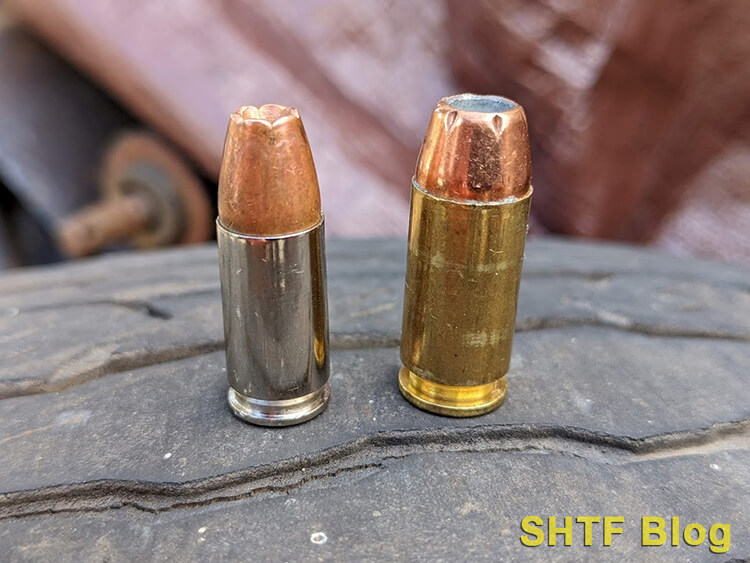
What’s better, .223 or .308? AR-15 or AK47? What about 9mm vs .40 S&W?
Shooters love debating this stuff. It’s a fact of life and a defining characteristic of the genre.
TLDR: The 9mm is the better all-purpose caliber. It is less expensive, has less recoil, and can be bought in large quantities for less money.
Throw in a certain aspect that a gun/caliber/optic/accessory/combination needs to be superior at, (plinking, steel targets, self-defense, survival, hunting, etc.) and holy crap – advocates and nay-sayers will materialize from behind trees and cars and your mom’s refrigerator just to have a run at arguing that their setup and opinion is best.
It’s friggin’ great, and if you don’t take it too seriously, debate is a great way to learn things and maybe even teach others based on your experience.
That being said, listen (or, rather, read) up – here’s your opportunity to enter a great debate and throw your hat in the ring based on your experience. After you, you know, read my opinions.
But first: some history on our projectile-launching protagonists.
9x19mm Luger History
The cartridge that came to be known as the 9mm Luger or 9mm Parabellum (a Latin term meaning “prepare for war”, from the German armaments manufacturer DWM’s motto “si vis pacem, para bellum”; translated – “if you want peace, prepare for war.”) was finalized early in the 20th century when its inventor, Georg Luger, modified a previous smaller military cartridge into a new rimless case with a larger 9mm (.355”) diameter bullet.
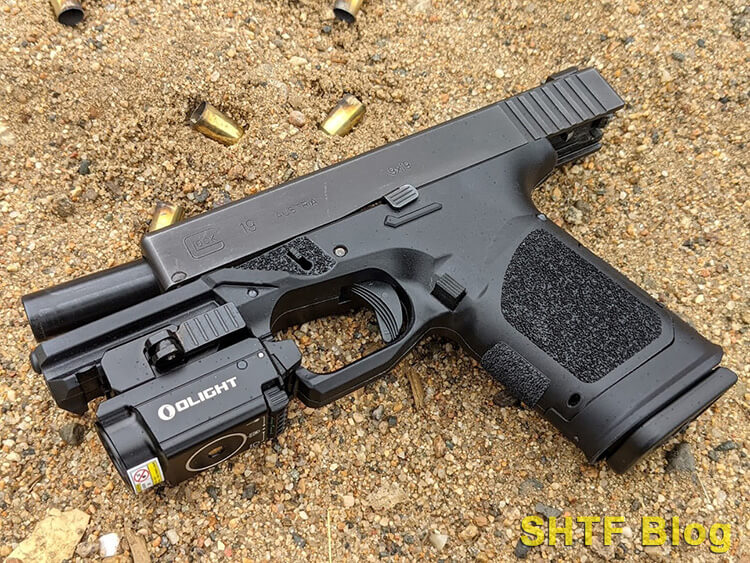
This size increase came at the insistence of the German military, who was leery of the performance of the previous 7.65mm caliber that Georg Luger was working with.
Mr. Luger finalized the cartridge in 1901, and in the following years championed his new chambering with his famous toggle-action P08 Luger pistol, submitting the combination to several military committees, including the British Small Arms Committee and the American Springfield Armory. The 9mm and Luger pistol were formally adopted by the German Navy in 1904, followed by the German Army in 1908.
Since then, the 9mm’s purpose and utility has evolved drastically, and it has since been adopted as the standard sidearm and submachine gun caliber for most of the world’s military branches and most police departments.
The 9×19 has slugged it out with foes for well over a century: through two world wars and myriad smaller conflicts on the battlefield and the streets, the 9mm is responsible for likely hundreds of thousands – if not millions – of casualties, cementing its place in history as one of THE definitive handgun and submachine gun calibers in history.
.40 Smith & Wesson History
The .40 Smith & Wesson cartridge is a direct consequence of the 9mm, though not a true descendent. After the less than stellar performance of the FBI’s Smith & Wesson 9mm semi-automatic sidearms (and .38 Special revolvers) that were involved with the infamous 1986 FBI Miami shootout, the FBI started looking for a handgun caliber that would offer superior terminal ballistics than the 9mm Silvertip or .38 Special +P LSWCHP loads that the FBI had been issuing up to that point.
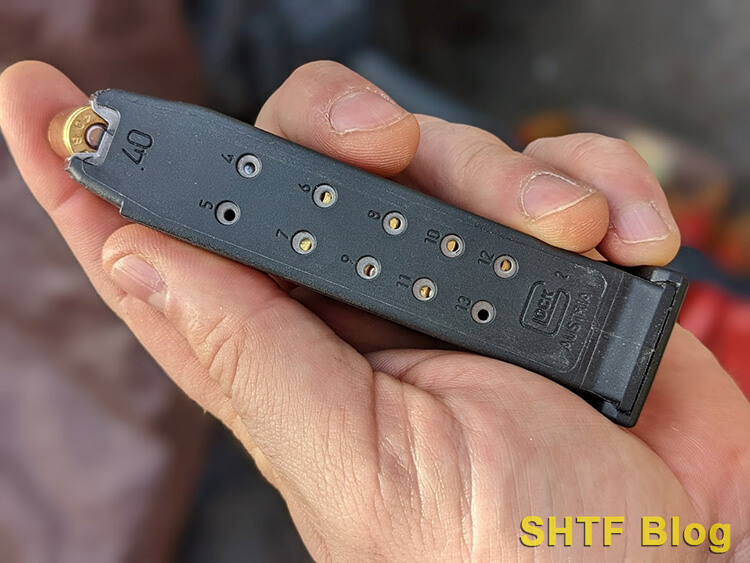
Further development and testing of the 9×19 and the .45 ACP occurred, and the FBI eventually adopted the 10mm Auto and Smith & Wesson’s beefy Model 1076 pistol as an immediate reaction to the shootout. However, complaints about the stout recoil of the 10mm brought the FBI back to the table, and options were further considered. Lightning struck when John Hall, the FBI’s Firearms Training Unit’s agent in charge, brought in his personal 10mm Colt Delta Elite with specialty handloaded ammunition.
After testing revealed that the 10mm launching 180 grain bullets at a lower-pressure 900-1,000 feet per second would fulfill the needs of the department, the FBI teamed with Smith & Wesson and developed the shorter .40 S&W, which delivered the desired performance without the large pistol frames and heavy recoil that were a by-product of the 10mm Auto.
As they say, a star was born, and the new .40 caliber hotness was released to the wild on January 17th, 1990 (I remember the gun magazines headlines were dominated for months!). The .40’s shorter case meant that handgun designs chambered in 9mm could be adapted for use with the new chunkier caliber – albeit at the expense of the 9mm’s higher magazine capacity.
Smith & Wesson immediately introduced their third-generation S&W Model 4006 in the new caliber, and Glock jumped on the bandwagon immediately with their Model 22. The FBI formally adopted the Glock in 1997, and police departments and other agencies followed suit very quickly, ditching their chunky .45 ACP handguns and puny 9mms and .38s for the new hot-rodded caliber that everyone saw as the great caliber panacea: controllable to shoot with a respectable magazine capacity like the 9mm, but with the additional bullet weight and girth that comes along with calibers starting in “4”.
The “Federal Assault Weapons Ban” of 1994 provided even more impetus to sales for the .40 S&W, as magazines for new guns were limited to the 10 rounds mandated by the government. With the 9mm’s magazine capacity advantage bureaucratically denied, new gun buyers went with the larger case and higher horsepower levels of the .40 S&W instead of the smaller 9mm.
However, in recent years, the .40 S&W’s “king of the hill” sales crown has been tarnished and eventually handed to the 9mm as availability of inexpensive 9mm surplus ammo and arms started washing into the market, and as ammunition propellant and projectiles evolved the 9mm started taking back some of its lost sales ground.
Smaller framed shooters shied away from the .40’s slightly higher recoil, and operators galore started pushing the “more rounds in the magazine and lower recoil means more rounds on target” mentality – and suddenly the .40 S&W wasn’t taken so seriously anymore.
Sales have dwindled drastically since the early 2000’s, and though they are available new, gun manufacturers now seem to treat the .40 S&W as an unfortunate byproduct of the 9mm – a consideration that is mostly lip service for the few diehards and departments that remain enthusiastic with the .40 S&W’s in-betweener concept.

Overview of the 9mm vs .40 S&W Argument
So here we are, at the crux of the matter: Which caliber is better and why? Going to almost any training course or online forum will net you people who run both calibers for their handgun needs, and all for good reasons. Research on the matter (which if you go down the online argument rabbit hole may drive you temporarily insane or perhaps give you a mild stroke) whittles down the main arguments to the following:
- The 9mm has less recoil – the .40 S&W is snappier to shoot. Less recoil means easier training, higher theoretical hit ratio on target
- The 9mm offers higher ammunition capacity in its magazines due to its overall smaller case diameter
- The 9mm is less expensive to shoot, with milsurp ammo being available in quantity. Less expensive ammunition means more can be bought for both training and stockpiling purposes.
- The 9mm is certainly utilized by a larger slice of the populace; as a consequence, parts, magazines, and other related item availability is possibly increased post-SHTF
- The 9mm benefits more from modern bullet technology (But wouldn’t the .40 benefit from the same technology? Hmm.)
- The .40 offers the capability of running heavier bullets and therefore theoretically higher energy imparted to the target
- The .40 is a card-carrying member of the “Caliber begins with a ‘4’” club. A bigger hole in the target is a bigger hole in the target
- The .40 and its pistols are rapidly becoming very available on the Police Department trade-in circuit, resulting in the availability of high quality used guns for little money.
Every single one of these arguments is deeply rooted in validity, but we’re not going to rehash them in detail in this article. You can literally go anywhere on the internet and run smack-dab into any of them and the reasonings behind the caliber justification.
While I may weave some of the above reasons in the duration of the rest of this article, let’s investigate further considerations and specifics that may be particularly valid to you, dear reader of a certain mindset.
Raw Ballistics
Let’s talk numbers, raw apples and oranges.
The basic 9mm load is usually a 115 grain or 124 grain projectile traveling at 1150-1200 feet per second out of standard 9mm handgun. Bullet weights from 50 grains to 185 grains in commercially loaded ammo, but the vast majority of 9mm ammo you’ll find is 115, 124, or 147 grain loads.
Muzzle energy for a 9mm 124 grain bullet at 1150 feet per second is just about 365 ft-lbs, putting the 9×19 roughly on par ballistically with the 158-grain .38 Special +P, but inferior to the .357 Magnum in all respects when fired from a handgun. 147 grain loads are commonly seen in the 9mm, but the slower velocities the heavier bullets produce mean less bullet expansion and higher trajectories, making hits harder at distance.
The parent case of the .40 S&W is the powerful 10mm Auto, but the .40’s case has been shortened to approximately 22mm in length from the 10mm’s 25mm length. This shortening, in effect, creates a relationship similar to the one a .38 Special has with the .357 Magnum, the .44 Special has with the .44 Magnum, and the .380 ACP has with the 9mm Luger.
That bit of trivia being said, the .40 S&W is no slouch in the performance department. 165 grain practice loads usually loaf along at 9mm velocities – 1,150 to 1,200 fps – but dedicated defense ammo can get serious. Hot-loaded commercial defense 135-grain defense ammunition will play on the same ball court as the fabled .357 Magnum, with some pushing the 135-grain JHP at an eyebrow-raising 1,400 fps, for almost 600 ft-lbs of energy at the muzzle: a serious jump over the 9mm.
More controllable 155-grain JHPs are available running about 1,200 fps, but these loads are still producing over 450 ft-lbs of energy. The .40 S&W benefits from simple physics: a bigger object moving as fast or faster hits harder.
The 9mm has the theoretical edge in penetration capability, however; the longer-for-the-diameter heavier bullet 9mm loads will usually penetrate further than the fatter, shorter .40 pills, all other things being equal. So, if you’re planning on shooting through car doors or barriers, the 9mm may be the way to lean.
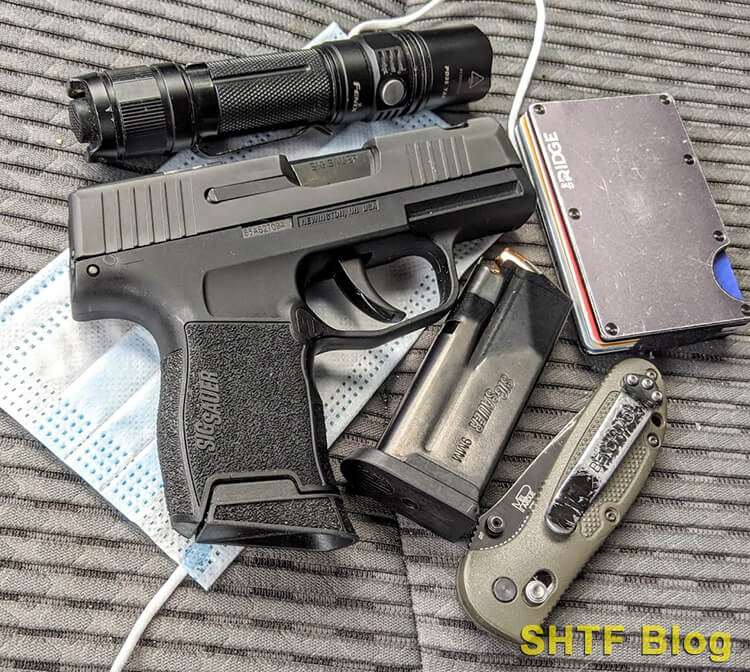
Below are tables with information I have personally chronographed. They show velocity at the muzzle in feet per second, with the energy calculated out and stated in foot-pounds of energy. I then listed out the improvement the carbine offers over the handgun total, and per additional inch of barrel. Numbers are rounded.
In the 9mm’s corner, the firearms were a SIG Sauer MPX-C with a 14.5” barrel and 1.5” flash hider, and a SIG Sauer P320 Compact with a 3.9” barrel.
The .40 S&W numbers were produced from a Ruger PCC carbine with a 16.1” barrel, and a Glock 23 with a 4.02” barrel length.
9mm ammunition used was Federal American Eagle 115 grain FMJ, PMC Bronze 115 grain JHP, and SIG Sauer V-Crown Elite 124 grain JHP. I didn’t have any 147 grain 9mm loads available to test.
.40 S&W ammunition tested was Cor-Bon 135 grain JHP, Remington 155 grain JHP, and the old tried and true Winchester “white box” 180 grain FMJ.
All data was taken approx. 7 feet from the muzzle with a Competition Electronics ProChrono Digital chronograph.
- Introducing the ProChrono DLX ballistic chronograph with improved accuracy specs and built-in Bluetooth
- Built in full featured operating system with multiple shot string memory and statistics
- Internal and external refinements with updates to the circuitry and enclosure design
- Faster internal shot clock for improved accuracy to plus or minus .5% or better
9x19mm Performance
| 9mm MPX – Federal American Eagle 115 grn FMJ | 1,321 Feet per second 446 Ft-lbs Energy | 208 FPS/129 Ft-lbs total 19.56 FPS/12 Ft-lbs per inch |
| 9mm MPX – PMC 115 grn JHP | 1,238 Feet per second 392 Ft-lbs Energy | 188 FPS/109 Ft-lbs total 17.61 FPS/10 Ft-lbs per inch |
| 9mm MPX – SIG V-Crown Elite 124 grn JHP | 1,315 Feet per second 476 Ft-lbs Energy | 188 FPS/129 Ft-lbs total 17.35 FPS/12 Ft-lbs per inch |
| 9mm P320C – Federal American Eagle 115grn FMJ | 1,113 Feet per second 317 Ft-lbs Energy | |
| 9mm P320C – PMC 115 grn JHP | 1,052 Feet per second 283 Ft-lbs Energy | |
| 9mm P320C – SIG V-Crown Elite 124 grn JHP | 1,105 Feet per second 336 Ft-lbs Energy |
.40 Smith & Wesson Performance
| .40 S&W PCC – Cor-Bon 135 grn JHP | 1,522 Feet per second 694 Ft-lbs Energy | 300 FPS/246 Ft-lbs total 24.83 FPS/20 Ft-lbs per inch |
| .40 S&W PCC – Remington 155 grn JHP | 1,336 Feet per second 614 Ft-lbs Energy | 249 FPS/207 Ft-lbs total 20.61 FPS/17 Ft-lbs per inch |
| .40 S&W PCC – Winchester 180 grn FMJ | 1,052 Feet per second 442 Ft-lbs Energy | 143 FPS/112 Ft-lbs total 11.83 FPS/9.27 Ft-lbs per inch |
| .40 S&W Glock 23 – Cor-Bon 135 grn JHP | 1,222 Feet per second 448 Ft-lbs Energy | |
| .40 S&W Glock 23 – Remington 155 grn JHP | 1,087 Feet per second 407 Ft-lbs Energy | |
| .40 S&W Glock 23 – Winchester 180 grn FMJ | 909 Feet per second 330 Ft-lbs Energy |
We can really see that the .40 S&W really does punch out superior on-paper performance, especially when a longer-barreled carbine can be utilized to make use of the extra case capacity available. Of note is the fast-moving 135-grain Cor-Bon load, which offers an additional 300 feet per second velocity over the Glock 23’s shorter barrel.
With that extra velocity come more smackdown, and a getting-serious 694 ft-lbs. of muzzle energy. That’s a substantial increase over anything the 9mm has to offer – no matter what the platform is.
We need to remember, though – numbers are just that: numbers. We can bench race all day long throwing performance figures around; but what really matters at the end of that day is getting effective rounds on target. If the bullet is placed where it needs to be, that 100 fps, 30 grains of bullet weight, or .045” diameter difference really won’t matter much. But there’s more to consider in this 9mm vs. .40 S&W argument.
Numerical Superiority (and I Don’t Mean Bullet Diameter)
For the preppers and stockpilers among us, the 9mm has several distinct advantages. I mentioned this facet earlier, but the availability of 9mm ammunition sourced from the surplus market in large quantities for relatively less money is a deal breaker. Companies such as Palmetto State Armory and Ammoman make bulk ammo buys in 9mm easy – from 100 round boxes to 1000 round cases from lots of different manufacturers.
The current gun situation makes your diligence necessary if you’re shopping for bulk buys; apparently all the cool kids are doing it – you’ll frequently see “OUT OF STOCK” listed. But set alerts and keep an eye out – the ammo shows up.
The downside to the inexpensive bulk 9mm ammo purchases? The ammunition you will receive is absolutely mass-produced and can have quality issues – especially if it’s sourced from non-US countries or (I’m waiting for the fallout on this one!) the box has a picture of an animal on it (American Eagle being a noteworthy exception to this observation.).
The other negative aspect to this ammunition is that what you’ll get will almost certainly be stuffed with Full Metal Jacketed (FMJ) projectiles.
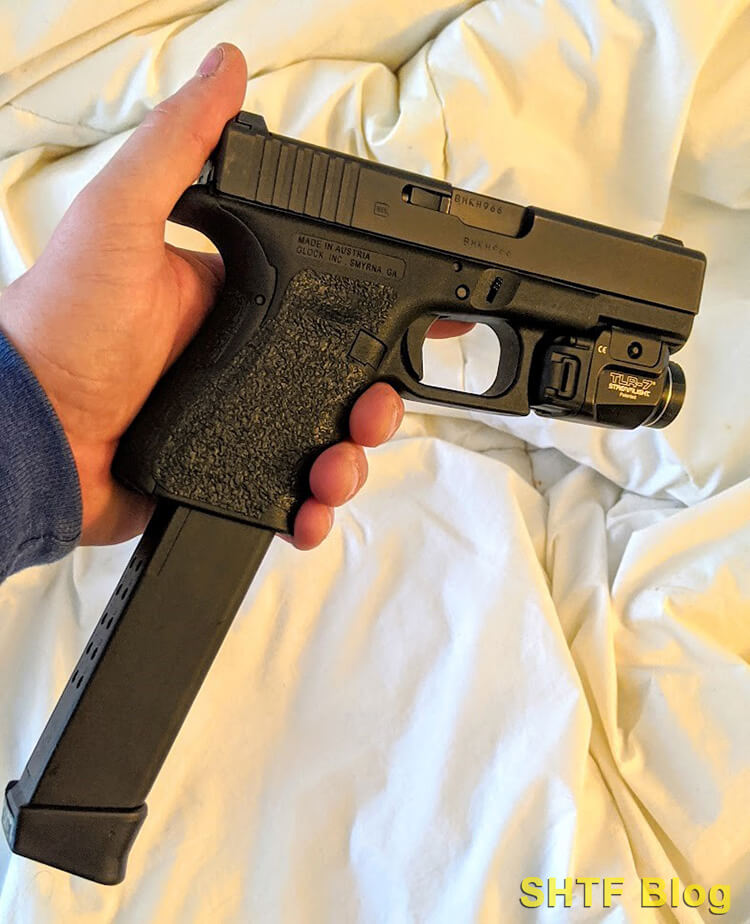
For those of you saying, “So what?”, I’ll proffer that the 9mm’s supposed superior terminal ballistics require modern, high performance hollow point or fragmenting bullets that are designed specifically for self-defense. The Hague Conventions of 1899 and 1907 specifically outlawed hollow point or soft point ammunition as being too destructive in war, so FMJ ammunition has been mandated for all military purposes. FMJ ammunition from a 9mm will do little more than penetrate and punch neat little clean holes in targets, paper or living – I don’t care if it’s 115, 124, or 147 grain ammo.
Yes, you got a great buy on a huge amount of the ammo, but its ballistic effectiveness is a drastic step backwards from modern HP ammunition. It beats a sharp stick in the eye, sure – but if you’re only going to be running FMJ rounds after a disaster scenario, the .40 S&W has the advantage due to its larger diameter. There, I said it.
Lesson I hope you’re pulling from this: buy some serious duty defense ammunition for your post-SHTF rigs too. It’s more expensive, yes, but it brings the 9mm’s better side to the table to your advantage,
Something else to ponder: having huge quantities of cheap 9mm ammo on hand means you probably have a great bartering stock too, if your disaster degrades that far. And most people will be running 9mms in theory – not so many .40’s – so chances are your 10,000 rounds of Tula cheapo 9 mike-mike will be more useful when the trading starts.
Carbine Compatibility
For those of us who don’t want logistics hassle or only have the ability/need to stockpile one specific caliber of ammunition, a pistol caliber that is carbine compatible offers a useful multiplication of force and simplification of required parts.
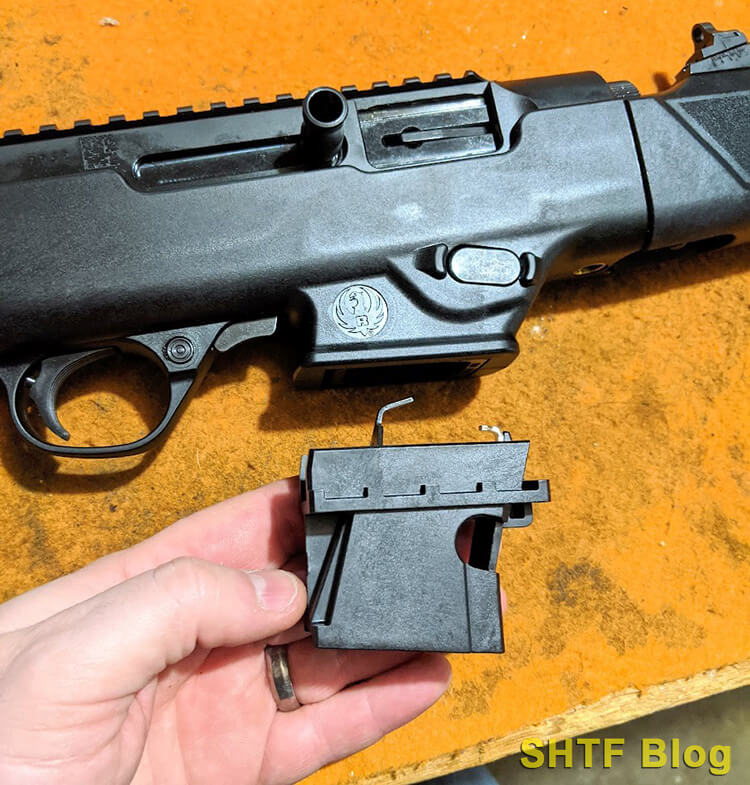
The go-to combination for many is a Glock 9mm handgun combined with a carbine – usually in the AR-15 configuration – that runs of Glock magazines. This pairing is incredibly useful and ensures that the operator need only stockpile one type of magazine and one type of ammunition for their home defense, plinking, and/or post-SHTF purposes.
The 9mm has more options in the carbine department, but manufacturers like Ruger offer the PCC Carbine in .40 S&W with the ability to feed from Glock magazines after a simple magwell change.
A carbine offers decided advantages over a handgun for the user. The carbine’s heavier weight really goes a long way towards mitigating recoil, especially with relatively puny handgun calibers like the 9 and .40; less recoil means faster, more controlled follow-up shots. The longer barrel of a carbine also means less muzzle blast. If you’re shooting indoors or without a suppressor this may make an appreciable difference to you.
The carbine’s four close-in points of contact (shoulder, left hand, right hand, cheek weld) offers vastly improved stability and accuracy over the handgun, which is held in one or two hands. The longer sight radius of the carbine means that precision with fixed/backup sights is more attainable and less susceptible to smaller degrees of operator movement. Also, the availability of optics, slings, and other attachments make the carbine more mission customizable to your specific needs.
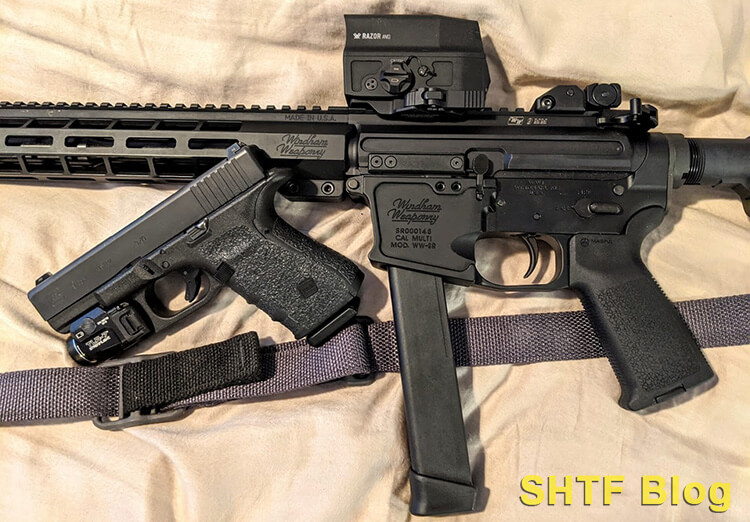
The fly in the ointment: neither the 9mm nor the .40 S&W have the case capacity to carry enough gunpowder to keep pushing the projectile down the entire length of a 14.5” or 16” carbine barrel. We saw this earlier with my ballistic tests: the result is that the 9mm or .40 pistol caliber carbine gain very little ballistic advantage over a pistol – just a couple hundred feet per second or so. The main advantage of the 9mm or .40 carbine lies in its negated recoil, added precision, and adaptability – not its increased horsepower.
Rolling Your Own
I handload almost all my ammunition – I’m cheap, plus I like the control and ability to dial-in a load to a specific gun or need. Handloading also offers us the option to store components – cases, primers, gunpowder, and projectiles – to manufacture ammunition as needed down the road.
Tailoring the loads to your needs – cheap cast lead, FMJ, or plated bullets for plinking or practice. Hard cast sharp-shouldered and flat meplat projectiles for penetrating game without ruining meat. Nasty fast-moving, gaping hollowpoint ammunition for defense or offense. It’s all there if you have the right gear, right components – and right knowledge coupled with experience.
So, what about handloading for the 9mm vs .40 S&W? Well, we have winners and losers here too. The 9mm continues the budget/cheap theme for its basic advantage of using a fraction less material to produce a completed cartridge. As stated before, the 9mm generally uses 115, 124, or 147 grain bullets, while the .40 S&W can run projectiles from 135 grains up to 200 grains.
If you’re casting lead bullets as part of your SHTF plan, every little bit of a finite resource savings helps – and that 20+ grains of weight difference between the 9mm and .40 S&W will add up over the long term.
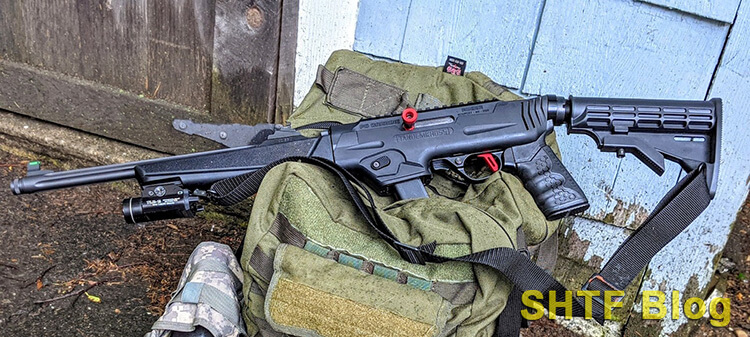
Also, the .40’s bigger bullets are, obviously, heavier – and the increased circumference of the outside of the bullet means more surface area for drag. This adds up to more powder being required to move the respective bullets to equivalent velocities. For example: One of my favorite powders for handloading both 9mm and .40 S&W is Hodgdon Titegroup.
My usual plinking/practice load for the 9mm is 4.1 grains of Titegroup under a 124-grain bullet; it nets about 950 feet per second out of a Glock 19. For the .40 S&W, I need to run 5.0 grains of the same powder to get a 180-grain bullet to 950 feet per second velocity out of a Glock 23. All this means that for one pound of Titegroup powder, I can load 1,707 9mm rounds or 1,400 .40 S&W rounds.
If all you have between you and eternity is one pound of powder and some components, will that 307 more rounds make a difference? It’s a distinct possibility. The 9mm wins this round.
However – the .40 possibly has an edge here to ponder if you’re running a carbine in this caliber. The 9mm has an internal case capacity of 13.3 grains of water (the standard unit of measurement for determining cartridge case capacity, by the way), whereas the chunkier, longer-cased .40 S&W boasts 19.3 grains of water capacity. Long story short: the .40 has more case capacity which you can pair with slower-burning gunpowder.
Combine these attributes with the shorter 135-grain or 155-grain bullets most .40 users run (they take up less room in the .40’s case than the heavier 180 and 200 grain bullets), and you have the ability to give your projectile a greater “push” for a longer distance down the barrel of a carbine, increasing the terminal ballistics over a .40 S&W handgun. Review the chronograph tables above for a reminder.
This doesn’t mean you can just stuff any powder into the .40’s case and give ‘er hell! A careful consideration for powder burn rates and charges is ABSOLUTELY in order if you decide to chase this route looking for every advantage. I haven’t personally experimented with this plan – though it’s on “the list” to try with my .40 S&W Ruger PCC. There are others out there online who have tried this plan – do your research and be careful.
Silent Running
Both the .9mm and .40 S&W are naturals to run suppressed. The capability for both to drive heavy-for-caliber bullets at subsonic speeds is there, but the 9mm certainly has the edge just in commercial subsonic ammunition availability. If you handload, it’s a different story of course.
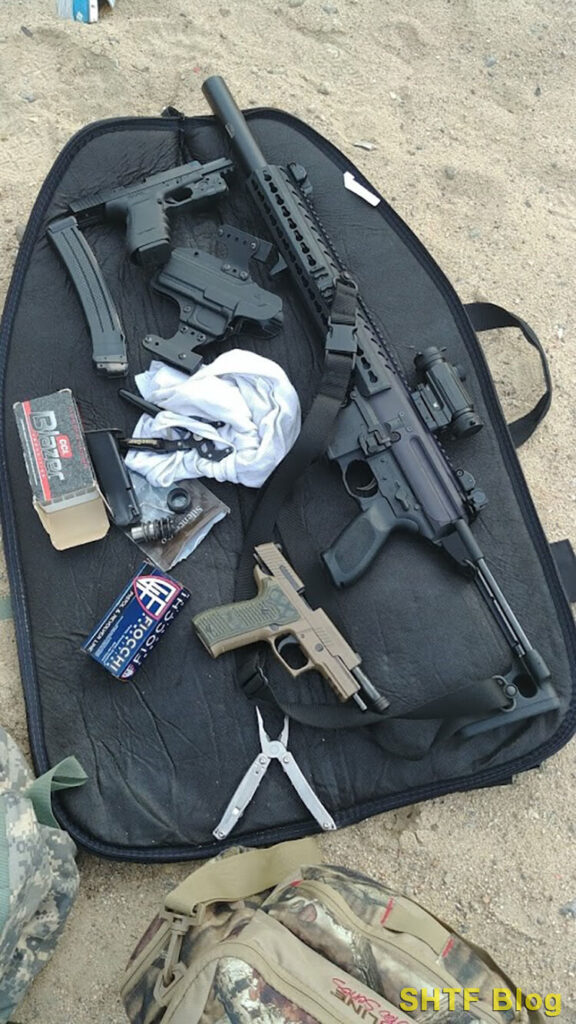
I don’t have much experience here, but past experience and research tells me that slow-moving bullets don’t expand and provide the terminal interior ballistics a fast-moving will, so it would seem to me the heavier, wider bullets available for the .40 would provide an edge here in effectiveness against game or stuff that shoots back.
If you have any experience with the 9mm vs. .40 S&W running a can, please lend us your $.02 in the comments below for us to learn from!
Real Life Experiences Using the 9mm and .40 S&W
I have used both 9mm and .40 S&W handguns as daily carry guns, shot competitions with both calibers, and trained heavily with both calibers. My past carry guns have included a Glock 27 in .40, a Smith & Wesson M&P40C in .40, a Smith & Wesson M&P 40 full-sized in .40, a SIG Sauer P320 in Subcompact, Compact, and Full-sized configurations in 9mm, a Smith & Wesson Model 39-2 in 9mm, a SIG Sauer P365SAS in 9mm, and a Glock 19 in 9mm.
Every single one of these pieces has or had thousands of rounds run through them and had many miles riding my belt carrying concealed or on belt duty; the only exception is the P365SAS, which is relatively new to me, and I just haven’t racked up the rounds through it.
Every single one of these pistols has been reliable to a fault, and I would without compunction pick any of them up to utilize to save my life or punch holes in an IDPA match. The lesson here is clear to me through experience: buy superior firearms, maintain them well, feed them quality ammunition, and they will run when you need them to – REGARDLESS OF CALIBER. Reliability is not an issue in this 9mm vs .40 S&W argument.
Accuracy with both calibers is fine as well. In your better off-the-shelf combat guns like the Glock or M&P or a SIG, neither caliber will be a scorching barn burner in the accuracy department but will certainly be combat capably accurate.
With handloads, I found I got slightly better results with the .40 S&W, but not so much better that I would race out and prefer the .40 just because it was more accurate with some handloads. With factory ammo, either caliber is entirely adequate for what I need the guns for.
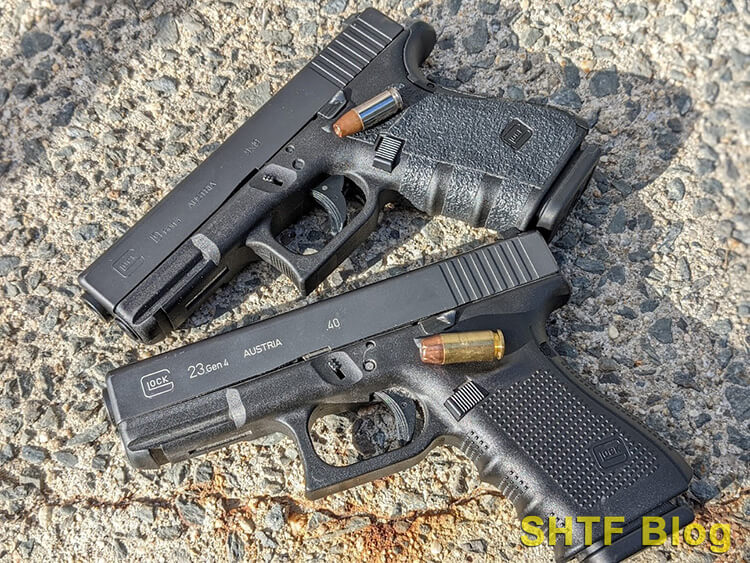
I have never pulled the trigger on a carry gun in defense (and hope to keep that record!), but I have personally shot or have seen whitetail deer shot with both 9mm and .40 S&W at short ranges. I came upon a deer hit by a car that was struggling to move; it was clearly on its way out.
After a call to the wardens with the explanation of the situation and the area, I got the OK to dispatch the deer with my carry gun (at that time, the Smith & Wesson 39) to put the animal out of misery. A 115-grain Cor-Bon high in the deer’s neck dropped the animal instantly, and it died on the spot with no fuss. Another time, I let a buddy shoot another car-injured deer with my Glock 27 off an unimproved road.
The deer was standing broadside, and it received a potent 155 grain Remington JHP right in the heart. The deer jumped and ran almost 40 yards before falling and expiring.
Both calibers did the job on animals that were previously injured; however, in my mind these scenarios show the importance of vital hits; if the bullet is placed in the central nervous system, threats can stop practically instantly; bullets placed in the circulatory system can delay the results, especially if the target is previously anguished or hurt.
Either caliber would have sufficed perfectly in either scenario. I know deer are different from bad guys, but the lessons learned can be applied equally well to either target.
I’m not sure if it proves or provides anything, but my EDC guns these days are a Gen 4 Glock 19 and a SIG Sauer P365 – both in 9mm. I personally carry a 9mm because good defense ammo is a bit easier to find and handloading for training ammo is more frugal; if I had to trade these guns in for their .40 S&W equivalents, I would simply say, “Cool.” and carry on.
Recoil is snappier in the smaller guns, but I have found that with larger guns like the Glock 22 or full-sized M&P, the .40 is very controllable. My little M&P40C was whippy but still easy to shoot with practice – and it was very accurate! If a .40 is all ya got, train with it, run it, and don’t look back! Training and mindset will make a headier difference than caliber.
What Other Experts Say
I put calls, emails, and text messages in to several friends who had extensive experience with both the 9mm and the .40 S&W to try to get a handle on what people were carrying and planning with – and why. The dais included men whose opinions I greatly respect; they hail from all walks of life and levels of experience.
I was able to pick the brains of a survivalist/prepper/college professor, a prepper Marine, two long-term gun guys and preppers, an ex-Texas Border Patrol Agent, a current duty WV police officer who also served in the US Army and WV State Police as a firearms trainer, and a local State Trooper/USCG Reserve friend. All have experience and opinions on the matter, but the results were interesting.
The prepper crowd seemed to have a different mindset and reasoning than the LEO/Armed forces crowd. The more specific prepper friend, Derrick James of this site, stated that he was 9mm all the way because:
It is more common. Having a common caliber ammo means it’s more valuable post collapse.
It can be used for bartering better than the .40. Also, I like the other ‘common caliber’ aspect, being more versatile with other platforms. You can use 9mm in a handgun and an AR platform.”
Another gun guy/prepper led off with:
The only thing that the 9mm has going for it is that it’s cheap. I prefer the .40…. but only because the guns for which this round is chambered are of medium size and generally lighter and with a .45 [ACP] which is what I honestly prefer. But the .40 is a decent compromise.
He also opined that serious self-defense ammo should be in the 155-165 grain weight range where possible.
The professor (long time readers of the site might know who I’m talking about) said:
I’d agree that a hopped up .40 might have some ballistic advantages over the 9, but not by much. So the 40 vs 9 debate is not the same as the .45 vs. 9 debate. Those two rounds approach the issue differently. The 9-40 comparison, in my mind, is one of small differences out of the muzzle but big differences with ammo type and availability, gun choice, spare parts, initial gun design, and whether you hang out at the mall.
Proving a point as to what the general populace thinks of the issue, he states, “But the big answer here is that pawn shops are flush with .40s while the 9 is scarce.”
It was interesting to me (but not surprising) here that the non-military types had some basic ballistics on their minds for sure, but expense and sheer quantity seemed to be first in their minds with the issue, along with platforms the caliber was chambered in. While in another email he definitively stated, “the 9mm is king”, the professor didn’t seem to care much about terminal performance, inferring that the two calibers really weren’t that different in the big scheme of things.
A good prepper buddy – the Marine – was succinct when he said, “I just like .40 better.” When I pressed him further, he said, “Just like the bigger bullet.”
The Border Patrol gentleman was on the Texas frontier during the 80s, 90s, and ‘00s, and during his time he saw the transition from revolver rounds to autopistols. A veteran of several gunfights, he saw firsthand the efficacy of the calibers – even shooting a perp with a 9mm. He said he was issued the 124-grain 9mm Winchester Silvertip ammo (the same ammo that was maligned in the FBI Miami Shootout), and the unlucky recipient he shot still had the juice to drive over a mile down a levy, to expire afterwards.
As a result, he stuck with the .357 Magnum – which he said never failed to produce one shot stops – well into the 2000s. He said that both calibers worked, but honestly the .40 S&W with a hot 155 grain JHP was better at stopping trouble, and the 9mm in the MP5 submachine gun was highly touted.
My State Trooper/USCG buddy actually called me after I texted him because he wanted to discuss the 9mm vs. 40 concept in detail. (I wish I’d taken better notes – he had a lot of great points to make!) He had been issued the 9mm Beretta M9 and the .40 S&W after the Coast Guard transitioned to the SIG Sauer P229DAK.
While he’s shot plenty of road-hit deer with his current issue HK .45 ACP, he stated he’d never had to use a sidearm against a human on duty, while in the State Police or the USCG. However, he shot them both extensively during training and hands-down chose the 9mm as his preferred tool. He noted that even with the heavy stainless steel slide, the SIG in .40 could be snappy to shoot accurately, and there were training difficulties with smaller-statured users or people with small hands.
It was far easier to get the trainees to master the 9mm, even with the big Beretta, because the recoil wasn’t as severe. Being able to master the 9mm in a more expedient fashion meant more shooter confidence, lower ammo expenditure for the same or lesser results, and a generally easier time getting people onboard with the sidearm.
He also stated that mag capacity was a big priority for him, especially based on his work working alone as a State Trooper. He told me that if he knew that he was heading into danger with a gun that held 18 9mm rounds versus a .40 with 12 or 13, that was a huge game changer; the 9mm would get the nod.
My pal in WV speaks from a long term of service with the 9mm and the .40, being issued both calibers over the course of a career in the Army, WV State Police, and his current posting as a sergeant in a local police department. He currently carries a Gen 5 Glock 17, but in the past carried a Gen 3 Glock 23 as well as a Smith & Wesson 4006, both in .40 S&W.
He told me via a text message conversation:
My opinion is the bad guy is unlikely to examine the bullet after it hits him to determine what it was. I’ve seen several people killed by .380 HP. I’ve also seen people survive getting shot with a .40. It all comes down to the training and mindset the shooter possesses. Whether it’s a 9 or .40 is inconsequential. The 9 is more pleasant to shoot by far. I’d take my [Glock] 17 over the 23 hands down. But 17 vs. [Glock ] 22 (Glock’s full-sized .40) I don’t care which. In a deadly force encounter you’re not going to care about recoil.
Echoing the State Trooper’s sentiment, he stated, “that being said, you need to be comfortable while training or the encounter in order to be proficient.”
I asked him, “So in your mind, the debate is more about the journey to proficiency than the effectiveness of the tool when you use it?”
He replied, “that’s a good way to put it. I don’t think there is any real-world difference between the two in terminal performance on human targets given a quality HP (hollow point).”
In my mind, he underlined the great common denominator when it comes down to the 9mm vs. 40 S&W debate – there is a more important factor at work than what gun you carry.
“Bottom line is most people don’t train. Or train enough.”
Wrapping It Up
So, we probably need a definitive answer after all this reading, don’t we? My takeaway after years of using both calibers and discussing the debate with people far more knowledgeable than I is this:
It doesn’t really matter. So go with the 9mm if you can source the proper ammunition.
How’s that for simple?
The 9mm is less expensive. The 9mm recoils less so training is more productive and effective. The 9mm can be bought in large quantities for not a bunch of money if you want el cheapo training ammo or bartering fodder. The 9mm is produced in tiny, subcompact, compact, and full-sized guns, ensuring that the gun you need is out there. All around, the 9mm seems to be the best deal.
HOWEVER…
If you live in an area that does not allow proper defense, frangible, or hollowpoint ammunition, the .40’s more sizable girth punches bigger holes and transfers more energy in your targets, which is what you’ll need to resort to when the chips are down and expanding ammo is off the table.
As car guys say, there is no replacement for displacement – and sometimes bigger is better. (Especially if you’re running a carbine!)
Comments? Questions? Thoughts that accentuate? Light up the comments section below and let us know what you use…and why.


12 comments
Cold climate a 40 is better. A 9 has terrible problems penetrating layered clothing unless your using +p ammo which isn’t cheap. Also I’ve had 9’s bounce off deers skulls
A++++ The most outstanding Article on this subject 9mm vs. .40 on the net. I don’t like to shoot twice as much with 9mm as with .40. .40 180 grain hits same if not harder than the 230 grain .45 ACP. Here is an idea………
Thanks SID!
Hague convention* not Geneva
Thank you Will! You’re absolutely correct.
I appreciate your real world perspectives; most reviewers just dump a bunch of rah-rah figures and claims while ignoring the practical aspects. Keep up the honesty.
Thanks, Mel. The unfortunate reality is that many prepper websites aren’t run by preppers at all. They’re owned by companies who just fold prepping sites into their larger portfolio of websites and hire freelance writers to generate generic content and lure traffic. We’ve tried to keep it real over the years.
One of the best articles I’ve read summing up differences between the cartridges.
The only fly in the ointment is the paragraph about powder burn and carbines. It matters not that the barrel is longer than the powder burn time. Velocity is half the energy equation and getting several hundred added feet per second tremendously increases the lethality of both rounds.
If you doubt it, IIIa soft body armor is rated for stopping pistol rounds but specifically states it is ineffective when they are fired from a carbine. Energy/velocity matters.
9mm The King of optimum.
I would like to thank you for taking the time to write your comparison article. Unlike most articles I have seen written, yours seems to be as objective as one can be when comparing and contrasting the two cartridges. Most of us, if not all of us are biased to one or the other for a multitude of reasons and generally read an article looking for substantiation of our bias. For the record, I have guns chambered in both calibers and like both. The only reason I own the .40’s is because the guns were able to be purchased new at a substantial discount due to the waning popularity of the 40 S&W cartridge. I think the cartridge has a lot of value yet I am not blind as to the fact that caliber choices can be quite fickle in their ability to stand the test of time. I am sure the 357 Sig and the 45 GAP had their high points, but neither has stood the test of time. Therefore, I have a healthy supply of ammo to feed my 40’s in the event popularity fades further like the 38 S&W or the 45 Auto Rim. Again, thanks for the article and the empirical data on performance in real world test firing.
Well done. Retired military, law enforcement, and more. Excellent points to emphasize, across the board. Whether a 22 or a 45, practice and accuracy are paramount. Availability is important. 45 is fantastic, but cost prohibitive, sadly. 9 is good all around. I was apprehensive to say the least when the military went to 9. Further research and practice changed my mind. Great perspectives to publish. To each their own. Put the projectile where it belongs. Thank you.
Retired Michigan State Trooper who has carried both and experienced the results of both. Both are very good rounds. It’s all about training and shot placement. Very minor advantages/disadvantages to both. Choose one you are comfortable with and train often. Both will perform well.